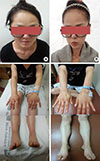Abstract
Reactions to Hymenoptera stings are classified into local reactions, large local reactions, systemic anaphylactic reactions, systemic toxic reactions, and unusual reactions. They are also classified into immediate and delayed reactions. The most frequent clinical patterns are large local and systemic anaphylactic reactions. The skin, and the gastrointestinal, respiratory, and cardiovascular systems can be involved. A variety of unusual or unexpected reactions, such as acute encephalopathy, acute renal failure, nephrotic syndrome, silent myocardial infarction, diffuse alveolar hemorrhage, rhabdomyolysis, and cataracts, occur in a temporal relationship to insect stings. Here, we report a 31-year-old woman with delayed generalized edema, weight gain, and unusual reactions 24 hours after bee sting.
Figures and Tables
References
1. Koterba AP, Greenberger PA. Chapter 4: stinging insect allergy and venom immunotherapy. Allergy Asthma Proc. 2012; 33:Suppl 1. S12–S14.

2. Hamilton RG. Diagnosis and treatment of allergy to hymenoptera venoms. Curr Opin Allergy Clin Immunol. 2010; 10:323–329.

4. Bilò MB. Anaphylaxis caused by hymenoptera stings: from epidemiology to treatment. Allergy. 2011; 66:Suppl 95. 35–37.

5. Bilo BM, Rueff F, Mosbech H, Bonifazi F, Oude-Elberink JN. EAACI interest group on insect venom hypersensitivity. Diagnosis of hymenoptera venom allergy. Allergy. 2005; 60:1339–1349.

6. Golden DB, Marsh DG, Kagey-Sobotka A, Freidhoff L, Szklo M, Valentine MD, et al. Epidemiology of insect venom sensitivity. JAMA. 1989; 262:240–244.

8. Ring J, Messmer K. Incidence and severity of anaphylactoid reactions to colloid volume substitutes. Lancet. 1977; 1:466–469.

10. Daher Ede F, da Silva Junior GB, Bezerra GP, Pontes LB, Martins AM, Guimaraes JA. Acute renal failure after massive honeybee stings. Rev Inst Med Trop Sao Paulo. 2003; 45:45–50.

11. Freye HB, Ehrlich B. Acute myocardial infarction following hymenoptera envenomation. Allergy Proc. 1989; 10:119–126.

12. Mukhopadhyay A, Fong KF, Lim TK. Diffuse alveolar haemorrhage: a rare reaction to insect sting. Respirology. 2002; 7:157–159.

13. Tanphaichitr VS, Tuchinda M. Severe thrombocytopenic purpura following a bee sting. Ann Allergy. 1982; 49:229–231.




 PDF
PDF ePub
ePub Citation
Citation Print
Print





 XML Download
XML Download